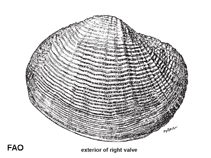Fimbria fimbriata (Linnaeus, 1758)
Common basket lucina| Native range | All suitable habitat | Point map | Year 2050 |

|
| This map was computer-generated and has not yet been reviewed. |
| Fimbria fimbriata AquaMaps Data sources: GBIF OBIS |
Classification / Names Common names | Synonyms | CoL | ITIS | WoRMS
| Lucinida | Lucinidae
Environment: milieu / climate zone / depth range / distribution range Ecologie
; diepteverspreiding 0 - 69 m (Ref. 8252). Tropical
Verspreiding Landen | FAO regio's | Ecosystems | Voorkomen | Introducties
Indo-Pacific: from Myanmar to Tonga; north to the Philippines and possible also Hawaii, and south to Queensland.
Length at first maturity / Size / Gewicht / Leeftijd
Maturity: Lm ? range ? - ? cm Max length : 9.5 cm SHL mannelijk/geslacht niet bekend; (Ref. 348); common length : 7.0 cm SHL mannelijk/geslacht niet bekend; (Ref. 348)
In sandy-coral bottoms, fully buried to completely exposed, in shallow water (Ref. 348).
Life cycle and mating behavior Geslachtsrijpheid | Voortplanting | Kuitschieten | Eieren | Fecundity | Larven
Members of the class Bivalvia are mostly gonochoric, some are protandric hermaphrodites. Life cycle: Embryos develop into free-swimming trocophore larvae, succeeded by the bivalve veliger, resembling a miniature clam.
Voornaamste referentie
Referenties | Coördinator | Medewerkers
Glover, E.A. and J.D. Taylor. 2007. (Ref. 8252)
Status op de Rode Lijst van het IUCN (Ref. 130435)
Status bij CITES (Ref. 108899)
Not Evaluated
CMS (Ref. 116361)
Not Evaluated
Gevaarlijk voor mensen
Gebruik door de mens
Visserij: commercieel
| FishSource |
Tools
Meer informatie
Populaire namen
Synoniemen
Predators
Voortplanting
Geslachtsrijpheid
Kuitschieten
Fecundity
Eieren
Ontwikkeling van de eieren
Synoniemen
Predators
Voortplanting
Geslachtsrijpheid
Kuitschieten
Fecundity
Eieren
Ontwikkeling van de eieren
Internet-bronnen
BHL | BOLD Systems | CISTI | DiscoverLife | FAO(Publication : search) | Fishipedia | GenBank (genoom, nucleotide) | GloBI | Gomexsi | Google Books | Google Scholar | Google | PubMed | Tree of Life | Wikipedia (ga naar, zoek) | Zoological Record
Estimates based on models
Preferred temperature
(Ref. 115969): 24.6 - 29, mean 28.1 (based on 1258 cells).
Prijsklasse
(Ref. 80766):
Unknown.



